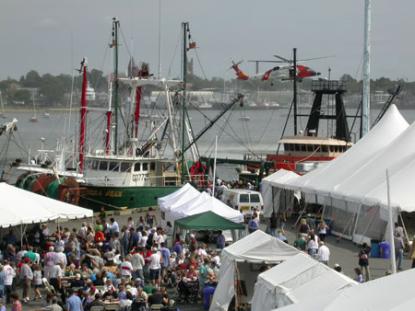In addition to describing two interesting and rich humanities projects funded by Mass Humanities, this post and the previous one by Harriet Webster provide examples of Mass Humanities’ Cultural Economic Development grants that are available to Massachusetts nonprofits—particularly those in economically ailing communities.
Cultural Economic Development (CED) Project Grants are for programs in the humanities that have the capacity to revitalize communities, stimulate income, create or enhance jobs, and attract tourism, and they may be eligible for an award of up to $10,000. Several examples of projects that received CED grants can be found by conducting a search in the “Grants Awarded” section of the Mass Humanities website. Have an idea that you think is fundable? Give us a call or fill out and submit our grant inquiry form and we’ll be in touch. Really.
That aside, let me introduce you to a new radio project called “Voices from the Port,” which radio listeners in and around New Bedford can tune into via Bristol County’s WBSM AM to hear a new series of firsthand accounts of life in the fishing community of New Bedford Harbor. The series will consist of four-minute segments, narrated by WCAI’s Naomi Arenberg, based on recorded oral histories of people involved in the commercial fishing industry and related shoreside businesses. The project received a Mass Humanities Cultural Economic Development grant in 2008.
 The voices of fishermen and women who fish, fishing family members and others were recorded over the past five years at the Working Waterfront Festival, a project of the Community Economic Development Center of Southeastern Massachusetts. The free festival, a family-friendly, educational celebration of New England’s commercial fishing industry, features live maritime and ethnic music, fishermen’s contests, fresh seafood, vessel tours, author readings, cooking demonstrations, kids’ activities and more. It has taken place in New Bedford, Massachusetts, America’s highest-earning fishing port, on the fourth full weekend of September since 2004; an estimated 15,000 people attend the festival annually. The festival features a “narrative stage,” from which authors give readings, musicians perform, and panelists discuss festival themes. In rooms on site, professional folklorists and anthropologists record accounts of fishing life from anyone who would like to contribute to their archive of interviews that capture details of this occupational culture.
The voices of fishermen and women who fish, fishing family members and others were recorded over the past five years at the Working Waterfront Festival, a project of the Community Economic Development Center of Southeastern Massachusetts. The free festival, a family-friendly, educational celebration of New England’s commercial fishing industry, features live maritime and ethnic music, fishermen’s contests, fresh seafood, vessel tours, author readings, cooking demonstrations, kids’ activities and more. It has taken place in New Bedford, Massachusetts, America’s highest-earning fishing port, on the fourth full weekend of September since 2004; an estimated 15,000 people attend the festival annually. The festival features a “narrative stage,” from which authors give readings, musicians perform, and panelists discuss festival themes. In rooms on site, professional folklorists and anthropologists record accounts of fishing life from anyone who would like to contribute to their archive of interviews that capture details of this occupational culture.
Laura Orleans, the festival’s founder and director and a co-producer of the radio series, is a trained folklorist. She has used her knowledge as a folklorist to create a variety of opportunities for people outside of the waterfront community to have access to what she calls “authentic experiences learning about the workings of a commercial fishing port.” Recording oral histories at the festival emerged as a way to “give the fishing industry a chance to tell its own story in its own way.”
The fact that the commercial fishing industry in the United States faces uncertain prospects underlies the zeal of festival organizers. Laura observes that in spite of a significant rebound in the populations of groundfish (that include such bottom-feeding species as cod, halibut, yellowtail flounder and ocean perch) and scallops in the waters off the coast of Massachusetts, economic indicators for the future of the industry are “not encouraging with the current management system.” She elaborates:
Because of the restrictive regulations, many small family fishermen will [not be able to stay in the business]. There is a ripple effect as a community loses fishing vessels, it cannot sustain its shoreside industries (things like ice, fuel, gear, clothing). This has made New Bedford strong in some respects: because of its size it has become a “hub” port, and many fishermen from smaller ports in the region come to New Bedford for services they can no longer get in their own ports. And the economic web is vast. For example, the average vessel spends $1,700 at a supermarket each time it leaves port just to feed its crew.
Regulations—and the threats to the livelihood of fishing that they impose—have emerged as major themes in the interviews collected so far. On the other hand, it’s important to be aware that commercial fishermen (and women) act as harbor stewards and conservationists, particularly since it’s in their best interests that species thrive. Regulations that have been designed by scientists and fishermen have had huge positive impacts on the fishery. According to the Working Waterfront website, fish populations have tripled since 1995, and scallop stocks are at 450 million pounds. Concurrent with this undeniably positive trend, fishing parents are discouraging their children from entering the trade because making a living at it is increasing difficult.
A related theme that has emerged in the interviews is the role that constantly evolving technologies has played in the industry, the lives of fishermen, and the health of the catch. In the beginning of the twentieth century, England’s steam-powered trawlers replaced schooner fleets and changed the methods for catching groundfish, increasing efficiency dramatically. Too dramatically, it turns out. By the 1960s the endangerment of the targeted fish stock was evident, due to the fact that international fishing fleets (using nets with small mesh sizes) began to utilize the waters near George’s Bank, an elevated portion of the sea floor between Cape Cod and Nova Scotia, depleting the groundfish stock. As a result, in 1976 the US Congress enacted the Magnuson Act, asserting control and regulatory power over waters 200 miles from shore. While this Act eliminated or reduced the threats posed by the international “factory trawlers,” new federal incentives for investors to enter the trade resulted in a large increase in the U.S. fleet of fishing vessels using the same waters. The groundfish stock did not rebound until 2002, when a fisheries rebuilding process that included fishermen and scientists initiated a series of regulations, such as catch limits and increased mesh size in fishing nets.
And of course—in addition to pressing concerns about the future of the industry—the stories that will be featured in “Voices from the Port” include tales of adventure: close calls, frightening storms, and days at sea waiting for calmer waters. The transcripts and recordings that Laura and her colleagues have been working with reveal something poetic and powerful, too: the call of the sea to many people involved with the trade. These are people who desire contact with water and wind and who develop a unique understanding of the oceanic world, not merely the business side of fishing.
Another industry central to “Voices from the Port” is tourism. The radio broadcasts will be available as MP3 sound files on a variety of New Bedford based websites including those of the Standard Times newspaper, the City of New Bedford, the Ocean Explorium at New Bedford Seaport, and the Southeast Massachusetts Convention and Visitors’ Bureau. Series producers hope that “Voices from the Port” will attract visitors—families on vacation and others seeking a maritime experience—to New Bedford. You don’t need to be within broadcast range to listen! Tune in or click on when June arrives for a whiff of sea air and the cadences of those who know the port, its vessels, and its rhythms of daily life.

Photos, Top: Galon "Skip" Barlow, inshore coastal fisherman from Buzzard's Bay, photo by Jon Robson
Bottom: Arial view of Working Waterfront Festival, photo by Jennifer Gonsalves


